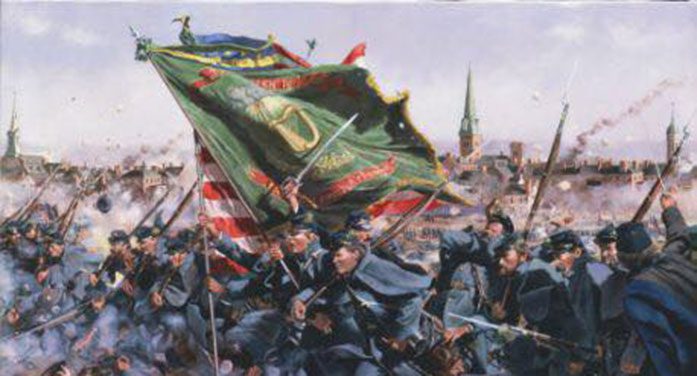 University of Toronto historian David A. Wilson has an interesting new book called Canadian Spy Story: Irish Revolutionaries and the Secret Police. It’s a detailed examination of a mid-19th-century episode that had the potential to turn Canadian history upside down. And Wilson makes a credible case that the danger wasn’t entirely farfetched.
University of Toronto historian David A. Wilson has an interesting new book called Canadian Spy Story: Irish Revolutionaries and the Secret Police. It’s a detailed examination of a mid-19th-century episode that had the potential to turn Canadian history upside down. And Wilson makes a credible case that the danger wasn’t entirely farfetched.
Following the conclusion of the American Civil War, the American branch of the Irish Republican Brotherhood – known as the Fenians – had big ideas. The plan was simple. They’d use the thousands of Irish-American ex-Union army soldiers as their military wherewithal to strike at Britain and win Ireland’s independence.
One of their scenarios involved an invasion of the British colonies in Canada. This was seen as having a number of possibilities.
A successful invasion might impel the British to do a deal on Ireland. You could call it a straight swap: we’ll vacate Canada if you vacate Ireland.
| MORE IN BOOKS | |
| John F. Kennedy: an anglophile for all seasons By Pat Murphy |
|
| Two women defined by and celebrated for a single book each By Pat Murphy |
|
| ‘Radical Joe’ Chamberlain inspires new British PM By Pat Murphy |
There was also the prospect of the invasion triggering a war between Britain and America, which would compromise Britain’s ability to suppress the planned uprising in Ireland itself. With British troops having to divide their attention between both sides of the Atlantic, the prospects of the Irish rebels would be significantly improved.
And an Anglo-American war could open the door to other options. A conquered Canada could be reconstituted as an independent republic. Or the Americans could just annex it. Both of these would be fine as far as the Fenians were concerned.
This invasion scenario envisioned active support from Fenian sympathizers within Canada, most of whom would be drawn from the significant numbers of Irish Catholic immigrants. At an October 1865 convention in Philadelphia, one Toronto Fenian declared that more than 100,000 Irish-Canadians were ready to support the invaders. It was only required to strike the match that would light the fire.
Plus, there would be at least tacit acquiescence from the U.S. government. Shortly before the Philadelphia convention, a Fenian representative discussed the invasion idea with the American president and his secretary of state, after which the representative reported that the Americans would “acknowledge accomplished facts.”
As events transpired, there were no fewer than five armed incursions between 1866 and 1871. Three of these occurred in 1866, one each in New Brunswick, Ontario and Quebec. But they failed and the whole thing eventually petered out.
What went wrong?
Irish-American Civil War veterans may have numbered in the tens of thousands, but the invading forces never remotely approached that scale. And the anticipated level of support from Irish Catholic immigrants didn’t materialize. Perhaps more support would’ve been forthcoming if the invaders had established a credible foothold lasting more than a few days. But they didn’t.
As for American government assistance, tacit or otherwise, it didn’t happen. Wilson puts it neatly: “And every time that the Fenians attacked or attempted to attack British North America … the Americans either stopped them or prevented them from bringing in reinforcements.”
The Fenian movement was also hampered by infiltrators and informers. There was a touch of irony here as the Fenians had set out to suborn Irish soldiers serving in British regiments stationed in Canada, only to find a similar tactic deployed against them.
Formed in December 1864, the Canadian secret police had originally been tasked with preventing Canada from becoming embroiled in the American Civil War by being used as a base for cross-border raids against Union states. Soon, though, the Fenians became the force’s main target, and extensive infiltration operations were undertaken on both sides of the border.
Traditional renderings of Canadian history tended to ridicule the Fenians as something akin to “comic opera.” More recent interpretations are less dismissive. But they situate the movement “largely as an external force, whose main contribution to Canadian history was to stimulate a sense of nationality and hasten the work of Confederation.”
While he welcomes the shedding of the “comic opera” theme, Wilson finds the recent historiography incomplete. He believes it downplays the resonance Irish nationalism had for Canada’s Irish Catholic community.
Wilson agrees that Fenian support within that community was always a minority proposition. And yes, Irish Catholics became socio-economically normalized rather quickly, at which point the Catholicism part of their identity assumed greater importance than the Irish nationalist part.
Still, the latter never quite went away. And in Wilson’s assessment, Fenianism was a real part of that Irish Canadian nationalist tradition.
Troy Media columnist Pat Murphy casts a history buff’s eye at the goings-on in our world. Never cynical – well, perhaps a little bit. For interview requests, click here.
The opinions expressed by our columnists and contributors are theirs alone and do not inherently or expressly reflect the views of our publication.
© Troy Media
Troy Media is an editorial content provider to media outlets and its own hosted community news outlets across Canada.


